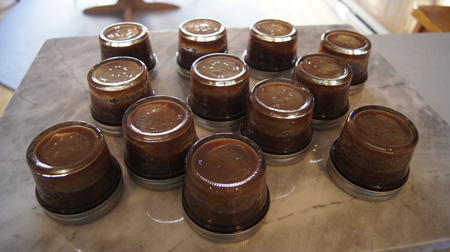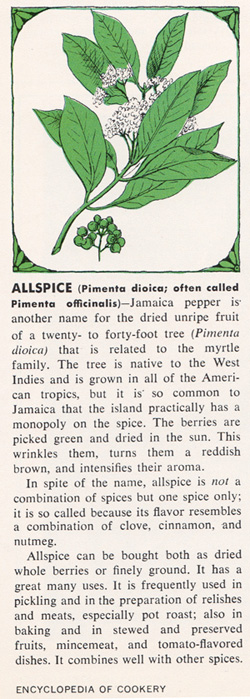Cookbook #83: Healthy Home-Style Cooking, Classic Pillsbury Cookbook, The Pillsbury Company, 1989.
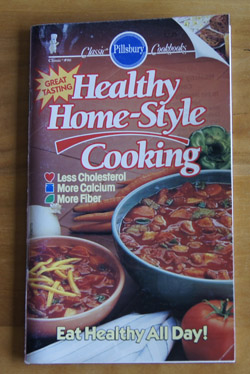 This pamphlet-cookbook offers “a contemporary healthful approach to light, sensible and delicious eating.” I can imagine myself 25 years ago, hungry, dieting, waiting in the supermarket check-out line, paging through this cookbook and seeing a few ideas for light meals or desserts.
This pamphlet-cookbook offers “a contemporary healthful approach to light, sensible and delicious eating.” I can imagine myself 25 years ago, hungry, dieting, waiting in the supermarket check-out line, paging through this cookbook and seeing a few ideas for light meals or desserts.
Most recipes in this cookbook shave off calories by employing low-calorie butter or low-fat milk products. Portion sizes are very small. For instance, Choco-Lite Brownies are only 70 calories each, but that’s because an 8-inch square pan of brownies is cut into 24 pieces. Lots of fresh fruits and vegetables are used in these recipes, as well as whole grains. That’s good.
Today I don’t find much inspiration in the recipes in this cookbook, so I will recycle it. For this blog, I decide to make the “Whole Grain Yeast Waffles” and “Strawberry Syrup”. Oddly enough, this recipe is in the Lively Main Dishes and Light Meals chapter. The lead-in to the recipe says “the batter can be made in advance to make hectic morning breakfasts a snap!” Guess since you make them at night, they are listed with main dishes. Hmm.
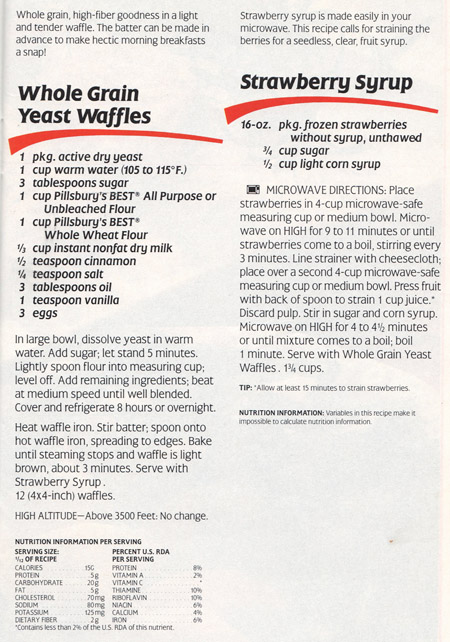 I have been making a similar yeast-leavened waffle for years; it differs a bit in that it uses fresh milk, no cinnamon, and only all-purpose flour. I like the idea of whole wheat flour in waffles, so I’ll try this new version. And strawberry syrup – I’ll make that too! What a treat this will be for a Wednesday morning.
I have been making a similar yeast-leavened waffle for years; it differs a bit in that it uses fresh milk, no cinnamon, and only all-purpose flour. I like the idea of whole wheat flour in waffles, so I’ll try this new version. And strawberry syrup – I’ll make that too! What a treat this will be for a Wednesday morning.
Whole Grain Yeast Waffles
makes 8-12 waffles
- 1 tablespoon yeast
- 1 cup water
- 3 tablespoons sugar
- 1 cup all-purpose flour
- 1 cup whole wheat flour
- 1/3 cup instant milk
- 1/2 teaspoon cinnamon (I used a bit more)
- 1/4 teaspoon salt
- 3 tablespoons oil
- 1 teaspoon vanilla
- 3 eggs
Mix the yeast, water, and sugar and let stand a few minutes. Meanwhile, stir together the flours, instant milk, cinnamon, and salt. Beat the eggs lightly, add the oil and vanilla, then stir into the flour mixture along with the yeast-sugar-water mixture. Mix until well-blended.
Cover with plastic wrap and refrigerate overnight.
Cook the next morning in a waffle iron. My batter was a bit thick for my waffle iron, so I thinned it with a bit of milk.
Strawberry Syrup
makes a little over a cup of syrup
- 16 ounce package frozen strawberries
- 3/4 cup sugar
- 1/2 cup light corn syrup
Put the frozen strawberries in a large bowl and microwave on high for about 10 minutes, stirring every few minutes. The strawberries will come to a boil and soften.
Let the berries cool a bit, then strain through cheese cloth or a chinois. Keep pressing the strawberries through the strainer with the back of a spoon. This takes awhile! You should get about a cup of juice.
Put the strawberry juice in a pan and add the sugar and corn syrup. Bring to a boil and boil one minute. If you prefer, you can put the berry-sugar-corn syrup mixture in a medium bowl and microwave about 4 minutes (until it comes to a boil) and then microwave one more minute.
Here’s my first waffle with strawberry syrup. I couldn’t wait – I took a bite before I crossed the kitchen to the table!
 Comments
Comments
The waffles were very good, wheat-y and hearty. And they were easy: no mixing in the morning, just quick waffles. I made them a bit thicker, because the batter only yielded 8 waffles. That makes them 225 calories each.
The strawberry syrup – the strawberry syrup! My thick syrup tasted just like very good strawberry jam. It was great on waffles, and I would love it on ice cream.
A couple drawbacks to this syrup. It took some time to strain and made a total mess of a lot of utensils:
 I cooked the strawberry-corn syrup-sugar mixture in a pan instead of the microwave.
I cooked the strawberry-corn syrup-sugar mixture in a pan instead of the microwave.
 Another drawback to this syrup? It is high in calories. The nutrition information for this recipe states: “Variables in this recipe make it impossible to calculate nutrition information.” That’s weird. I went online to Nutrient Facts and found the calorie content of sugar and corn syrup, and used the calories on the bag of strawberries to calculate that the full batch of syrup has about 1200 calories, and considering my volume, that’s about 75 calories per tablespoon. And I used more than one tablespoon. It is so good I could lap this stuff up.
Another drawback to this syrup? It is high in calories. The nutrition information for this recipe states: “Variables in this recipe make it impossible to calculate nutrition information.” That’s weird. I went online to Nutrient Facts and found the calorie content of sugar and corn syrup, and used the calories on the bag of strawberries to calculate that the full batch of syrup has about 1200 calories, and considering my volume, that’s about 75 calories per tablespoon. And I used more than one tablespoon. It is so good I could lap this stuff up.
I haven’t used corn syrup in ages. I was a bit concerned that it contained high-fructose corn syrup, but no, it says right on the package, “no high-fructose corn syrup”.
So the waffles and the syrup are great, but that’s because they are not exactly low-calorie. The cookbook failed me as a low-calorie source, but did not fail to give me a tasty and nutritious meal.

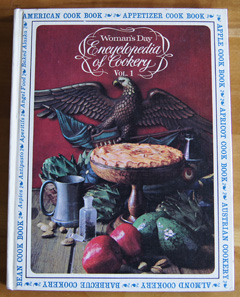
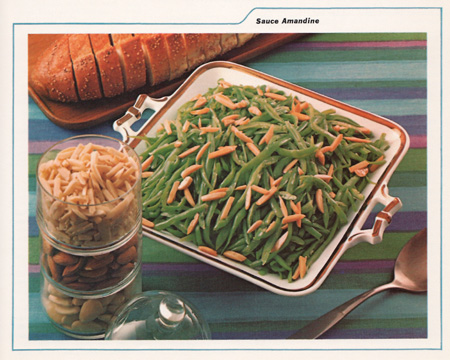
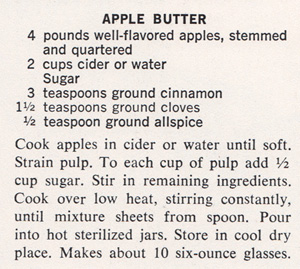

 I sterilized 12 of these cute little jars in boiling water, then filled them with the hot apple butter. Then I closed them with hot canning lids and set them upside down on the counter to cool.
I sterilized 12 of these cute little jars in boiling water, then filled them with the hot apple butter. Then I closed them with hot canning lids and set them upside down on the counter to cool.